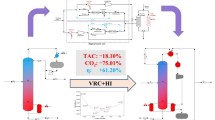Abstract
Performance of sulfur hexafluoride, nitrogen, argon, and helium inert gases was investigated in a view to produce fuel grade ethanol by diffusion distillation. Stefan–Maxwell equations based mathematical model was used for this study. Modeling results were also compared with the own experimental data. Shifting of azeotrope to different extents was observed by using different inert gases as selective filter. As the selected inert gas becomes lighter, narrow concentration range for positive selectivity was found. Sulfur hexafluoride was found to be the most suitable inert gas for ethanol dehydration by diffusion distillation, and quantity \({{S}_{{{\text{az}}}}}({{N{}_{2}} \mathord{\left/ {\vphantom {{N{}_{2}} {{{N}_{1}}}}} \right. \kern-0em} {{{N}_{1}}}})\), which represents the overall performance of any inert gas, was also found to be highest for this gas out of all the inert gases studied. Sulfur hexafluoride gas also allows to work at high vaporization temperature, which facilitates the high transfer efficiency. If light gases are to be used they should be used for high feed concentrations and at low vaporization temperatures to achieve the high degree of separation.









Similar content being viewed by others
REFERENCES
Kumar, S., Singh, N., and Prasad, R., Anhydrous ethanol: A renewable source of energy, Renewable Sustainable Energy Rev., 2010, vol. 14, p. 1830.
Balat, M., Balat, H., and Oz, C., Progress in bioethanol processing, Prog. Energy Combust. Sci., 2008, vol. 34, p. 551.
Kaminski, W., Marszalek, J. and Ciolkowska, A., Renewable energy source – dehydrated ethanol, Chem. Eng. J., 2008, vol. 135, p. 95.
Ward, O.P. and Singh, A., Bioethanol technology: Developments and perspectives, Adv. Appl. Microbiol., 2002, vol. 51, p. 53.
Kiss, A.A. and Suszwalak, D.J.-P.C., Enhanced bioethanol dehydration by extractive and azeotropic distillation in dividing-wall columns, Sep. Purif. Technol., 2012, vol. 86, p. 70.
IS (Indian Standard) 15464−2004: Specification for Anhydrous Alcohol for Automotive Use, 2004.
Abu Al-Rub, F., Distillation in capillary porous media for separation of biomass ethanol–water mixture, PhD Thesis, The University of Iowa, 1994.
Goodling, C.H., and Bahouth, F.J., Membrane-aided distillation of azeotropic solutions, Chem. Eng. Commun., 1985, vol. 35, p. 267.
Abu Al-Rub, F., Akili, J., and Datta, R., Distillation of binary mixtures with capillary porous plates, Sep. Sci. Technol., 1988, vol. 33, p. 10.
Udriot, H., Araque, A., and von Stockar, U., Azeotropic mixtures may be broken by membrane distillation, Chem. Eng. J., 1994, vol. 54, p. 87.
Fullarton, D. and Schlunder, E.U., Diffusion distillation − A new separation process for azeotropic mixtures Part I: Selectivity and transfer efficiency, Chem. Eng. Process., 1986, vol. 20, p. 255.
Singh, N. and Prasad, R., Fuel grade ethanol by diffusion distillation: An experimental study, J. Chem. Technol. Biotechnol., 2011, vol. 86, p. 724.
Singh, N. and Prasad, R., Experimental studies on the effect of inert gases on diffusion distillation of ethanol–water mixtures, J. Chem. Technol. Biotechnol., 2011, vol. 86, p. 1495.
Krishna, R., Panchal, C.B., Webb, D.R., and Coward, I., An Ackerman-Colburn and Drew type analysis for condensation of multicomponent mixtures, Lett. Heat Mass Transfer, 1976, vol. 3, p. 163.
Krishna, R. and Panchal, C.B., Condensation of a binary vapor mixture in the presence of an inert gas, Chem. Eng. Sci., 1977, vol. 32, p. 741.
Webb, D.R. and Sardesai, R.G., Verification of multicomponent mass transfer models for condensation inside a vertical tube, Int. J. Multiphase Flow, 1981, vol. 7, p. 507.
Taylor, R., and Webb, D.R., Film models for multicomponent mass transfer. Computational methods: The exact solution of the Maxwell–Stefan equations, Comput. Chem. Eng., 1981, vol. 5, p. 61.
Schlunder, E.U., Azeotropes and pseudo-azeotropes, Fluid Phase Equilib., 1989, vol. 51, p. 71.
Author information
Authors and Affiliations
Corresponding authors
Rights and permissions
About this article
Cite this article
Neetu Singh, Jai Prakash Kushwaha Performance of Different Inert Gases in Production of Fuel Grade Ethanol by Diffusion Distillation. Theor Found Chem Eng 53, 132–138 (2019). https://doi.org/10.1134/S0040579519010147
Received:
Revised:
Accepted:
Published:
Issue Date:
DOI: https://doi.org/10.1134/S0040579519010147




